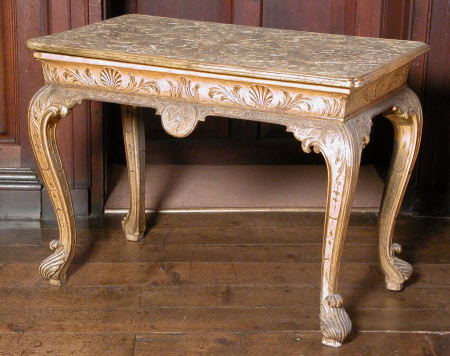Erddig's '1 Gold Table', 1720-25
Category
Furniture
Date
circa 1720 - 1726
Materials
Carved and gilded oak and softwood, red bole
Measurements
73.6 x 101.6 x 57 cm
Place of origin
London
Order this imageCollection
Erddig, Wrexham
NT 1146957
Summary
A carved and gilded side table, English, circa 1720-6. The rectangular top of oak and with re-entrant corners and moulded edge. Gilded and carved in shallow relief with foliated strapwork around a central four-pointed star. The ogee-profiled frieze decorated with a pair of shelves flanked by leaves, and carved with leaves to the corners. The flared aprons decorated with leaves carved against a punched ground, and with a central near-circular pendant medallion. The legs of cabriole form; the feet mounted with shells with scroll-over upper terminal.
Full description
This table stands in the room for which it was made, now called the Tapestry Room but, in 1726, when the contents of Erddig were inventoried, the Second Best Bedchamber. It was the only table with a gilt top in the house at the time, bearing out Adam Bowett's suggestion that 'gilt tops...were reserved for high status rooms'. Another table (NT 1164972) at Erddig, with a silvered finish and mirrored top painted with the Yorke arms, supplied by John Belchier (1717-1753) in 1726 for the Withdrawing Room adjacent to the Best Bedchamber, is similar, but not similar enough to be able to attribute both to the same maker. No bill for the table survives and so its maker is, as yet, unkown. (Megan Wheeler, 2019)
Provenance
Listed in the Inventory taken at Erddig in 1726 in the 'Second Best Bedchamber' (where it still stands, although the room is now the Tapestry Room). Thence by descent, and given by Philip Yorke III (1905-1978) along with the estate, house and contents to the National Trust in 1973.
References
Bowett 2009, Early Georgian Furniture 1715 - 1740 (2009), pp. 210-211, Plate 5:19 and 5:21
